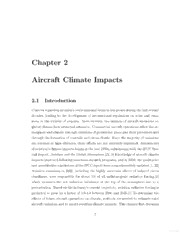
Aircraft Design for Reduced Climate Impact PDF
Preview Aircraft Design for Reduced Climate Impact
AIRCRAFT DESIGNFORREDUCED CLIMATEIMPACT A DISSERTATION SUBMITTEDTOTHEDEPARTMENT OFAERONAUTICS AND ASTRONAUTICS ANDTHE COMMITTEE ON GRADUATESTUDIES OF STANFORD UNIVERSITY IN PARTIALFULFILLMENT OF THEREQUIREMENTS FORTHEDEGREEOF DOCTOROFPHILOSOPHY EmilySchwartzDallara February2011 2011byEmilyDallara.AllRightsReserved. Re-distributedbyStanfordUniversityunderlicensewiththeauthor. Thisdissertationisonlineat:http://purl.stanford.edu/yf499mg3300 ii IcertifythatIhavereadthisdissertationandthat,inmyopinion,itisfullyadequate inscopeandqualityasadissertationforthedegreeofDoctorofPhilosophy. IlanKroo,PrimaryAdviser IcertifythatIhavereadthisdissertationandthat,inmyopinion,itisfullyadequate inscopeandqualityasadissertationforthedegreeofDoctorofPhilosophy. JuanAlonso IcertifythatIhavereadthisdissertationandthat,inmyopinion,itisfullyadequate inscopeandqualityasadissertationforthedegreeofDoctorofPhilosophy. MarkJacobson ApprovedfortheStanfordUniversityCommitteeonGraduateStudies. PatriciaJ.Gumport,ViceProvostGraduateEducation Thissignaturepagewasgeneratedelectronicallyuponsubmissionofthisdissertationin electronicformat.Anoriginalsignedhardcopyofthesignaturepageisonfilein UniversityArchives. Abstract Commercialaviationhasgrownrapidlyoverthepastseveraldecades. Aviationemis- sionshavealsogrown,despiteimprovementsinfuelefficiency. Theseemissionsaffect theradiativebalanceoftheEarthsystembychangingconcentrationsofgreenhouse gasesandtheirprecursorsandbyalteringcloudproperties. In2005,aircraftopera- tionsproducedabout5%oftheworldwideanthropogenicforcingthatcausesclimate change, andthisfractionisprojectedtorise.fl] Changesinaircraftoperationsand designmaybenecessarytomeetgoalsforlimitingfutureclimatechange. A frameworkispresented for assessingthecomparativeclimateimpactsoffu- tureaircraftduringconceptualdesignstudies. Alinearclimatemodelestimatesthe temperaturechangecausedbyemissionspecieswithvaryinglifetimesandaccounts forthealtitude-varyingradiativeforcingsproducedbyNOxemissionsandaviation inducedcloudiness. Theeffectsofdesigncruisealtitudeon aircraft fuelconsump- tionandNOxemissionratesaremodeledsimultaneouslybyintegratingtheclimate modelintoanaircraftdesignandperformanceanalysistool. Theaveragetempera- tureresponsemetricaggregatesthelifetimeclimatechangeimpactsfromoperating afleetofparticularaircraft. Lastly,uncertaintyquantificationstudiesareperformed todeterminethelevelofconfidenceinestimatesofrelativeclimateperformanceof competingaircraftconfigurations. Aircraftclimatechangemitigationstrategiesareinvestigatedwiththisframework. Withoutapplyingadditionaltechnologies,designingaircrafttoflyatMach0.77and 25,000-31,000ftaltitudeenables10-35%reductionsinclimateimpacts (and1%in- creasesinoperatingcosts) comparedwithmoreconventionaldesignsthatcruiseat Mach0.84,39,000-40,000ftaltitude. Thisresearchalsomodelstheperformanceof iv aircraftthatadoptpropfanengines,naturallaminarflow,biofuels,lowNOxcombus- tors,andoperationalcontrailavoidance. Aircraftflyingbelowfuel-optimalaltitudes incurafuelburnpenalty,butpropfanandlaminarflowtechnologiescanoffsetthese penaltiesandproducelargefuelsavings. Thesetechnologiesenablecollectiveclimate impactreductionsof45-75%simultaneouswithtotaloperatingcostsavingsrelative to aconventional, baselinetechnology, minimum cost aircraft. Uncertaintyquan- tificationstudiesdemonstratethatsignificantrelativeaveragetemperatureresponse savings canbeexpectedwiththesestrategiesdespitelargescientificuncertainties. Designstudiesillustratetheimportanceofincludingnon-C02effectsinanaircraft climatemetric: ifaircraftaredesignedtominimizeC02emissions,insteadofthetem- peraturechangecausedbyallemissions,thenpotentialsavingsarehalved. Strategies forimprovingtheclimateperformanceofexistingaircraftarealsoexplored,reveal- ingpotentialclimateimpactsavingsof20-40%,tradedfora1-5%increaseintotal operatingcostsandreducedmaximumrange. Acknowledgments Thisthesiswouldnothavebeenpossiblewithouttheguidanceandsupportofmany people. Iowemydeepestgratitudetomyadviser,ProfessorIlanKroo. Heembraced andsharedmypassionforenvironmentally-friendlyaircraftdesignandallowedme thefreedomtodrivethedirectionofmyresearch. Hisinsightsandpracticalguidance overthelastseveralyearshavehelpeddevelopedmyabilitytotacklenewchallenges andwillhaveapositiveimpactonmeasImoveforwardinmycareer. Mysincerethanksgotomembersofmycommittee,ProfessorsJuanAlonsoand MarkJacobson,forreadingthisthesisandprovidingthoughtfulcomments. Professor JohnWeyantcontributedsignificantly, bothbyservingasadefenseexaminerand throughusefuldiscussionsabout climatechangemetrics. Additionalthanksgoto ProfessorMargot Gerritsenforservingasmydefensecommitteechairperson. Our workintheareaofclimatemetricsalsogreatlybenefitedfromthefeedbackofMIT ProfessorIanWaitz. Lastly,IwouldliketothankSteveBaughcumfromtheBoeing Companyformanyhelpfulconversations,particularlyintheareaofcontrailavoidance strategies. Ifeelvery fortunatetohave been apartoftheAircraft Design Group. Over thepastseveralmonths,everymemberofthegrouphasprovidedmewithfeedback andsupportthathelpedshapethisresearch. IgreatlyvaluetheexperiencesIhave sharedwithourformationflightteam: GeoffBower, JiaXu, Tristan Flanzer, and AndrewNing. ManyotherfriendsonbothsidesoftheBayhavemademyyearsat Stanfordamongthemostenjoyableinmylife. SpecialthanksgotoNoelBakhtianfor bringingtheperfectamountoflevitytoourgraduateschoolexperiencesinEngland andCalifornia. vi Finally, Iwould not bein thepositionthat I am today withoutthe loveand supportofmyentirefamily. ThankstomyDadforalwaysbelievinginme,especially whenIdidn't believeinmyself. ThankstomyMomforhertirelessdevotionand sacrificeintakingcareofmybrothers,sister,andme. Thankstomyhusband,Chris, forgivingmylifebalanceandmeaning(andforproofreadingthisentiredocument). Thisthesisisdedicatedtohim. vii Contents Abstract iv Acknowledgments vi ] Introduction 1 1.1 GlobalClimateChange 1 1.2 AviationandtheEnvironment 4 L3 ContributionsandOutline 6 2 Aircraft ClimateImpacts 7 2J Introduction 1 2J2, AircraftEmissionsandClimate & CarbonDioxide 11 2.2.2 WaterVapor 12 2.2.3 NitrogenOxides 12 2JLA SulfurOxides Li 2.2.5 SootParticles 14 2JLf5 AviationInducedCloudiness 14 2.3 AircraftEmissionsRegulations 16 2.4 EmissionsModeling 16 2.4.1 Fuel-ProportionalEmissions 17 2.4.2 N0VP3-T3Method 17 9.4.3 FuelFlowCorrelationMethods L& 2.5 ClimateImpactModeling 18 viii i 3.5.1 GlobalClimateModels 13 2JL2 IntegratedAssessmentModels 19 2.5.3 LinearTemperatureResponseModels 2Q 3 ClimateChangeMetrics 21 3.1 Introduction 21 3.2 CommonlyUsedClimateMetrics 23_ 3.2.1 MassofEmissions 23_ 3.2.2 RadiativeForcing 23. 3.2.3 GlobalWarmingPotential 23 3.2.4 GlobalTemperaturePotential 24 3.2.5 DamagesandOtherEconomicMetrics 24 3.3 ClimateMetricforComparativeAircraftDesign 25. 3.3.1 DesiredMetricProperties 25 3.3.2 AverageTemperatureResponse 28 3.3.3 AlternativeAircraftDesignMetrics 34 4 AircraftDesignandAnalysisTools 35 4J Introduction 35_ 4.2 ProgramforAircraftSynthesisStudies 35 4.3 OperatingCosts 3ii 4.4 VariableBypassRatioEngineModel 37 4.4.1 EnginePerformance 41 4.4.2 EngineGeometry 44 4.4.3 NacelleParasiteDrag 46 4.4.4 WeightEstimation 49 4.4.5 CertificationNoise 52 4.4.6 EngineMaintenanceandAcquisitionCosts 54 5 LinearClimateModelwithAltitudeVariation 55 5J Introduction 5Ji 5J2 Emissions 56 ix i 5.2.1 CarbonDioxide,WaterVapor,Soot,andSulfateEmissionsIn- dices 51 5.2.2 NitrogenOxideEmissionsIndex 57 5.3 RadiativeForcing 60 5.3.1 AltitudeVariation 01 5.3.2 Carbon Dioxide 64. 5.3.3 MethaneandLong-LivedOzone 64 5.3.4 Short-LivedSpecies 65 5.3.5 AviationInducedCloudiness 61 5.4 TemperatureChange 67 £l5 LimitationsoftheClimateModel 69_ 5.6 UncertaintyQuantification 72 5.7 ComputingAverageTemperatureResponse 74 6 AircraftDesignStudies 78 6J Introduction 7& 6.2 AircraftOptimizationProblem 79 6.3 ResultswithBaselineTechnology 81 6.3.1 Single-ObjectiveResults 81 6^2 Cost-ClimateTradeoff 84 6.4 ResultswithClimateMitigationTechnologies 86 6.4.1 CO2ImpactReduction 86 6.4.2 NOyImpactReduction 94 6.4.3 AICImpactReduction 97 6.4.4 ComparisonofIndividualTechnologies 100 6.4.5 CombinationofTechnologies 102 6.4.6 AssessmentofClimateImpactUncertainty 104 6.5 AlternativeMetrics 109 6.5.1 ComparisontoResultswithC02-BasedMetric 109 6.5.2 ComparisontoResultswithOtherMetrics 110 6.6 Additional Studies 112 x 1
